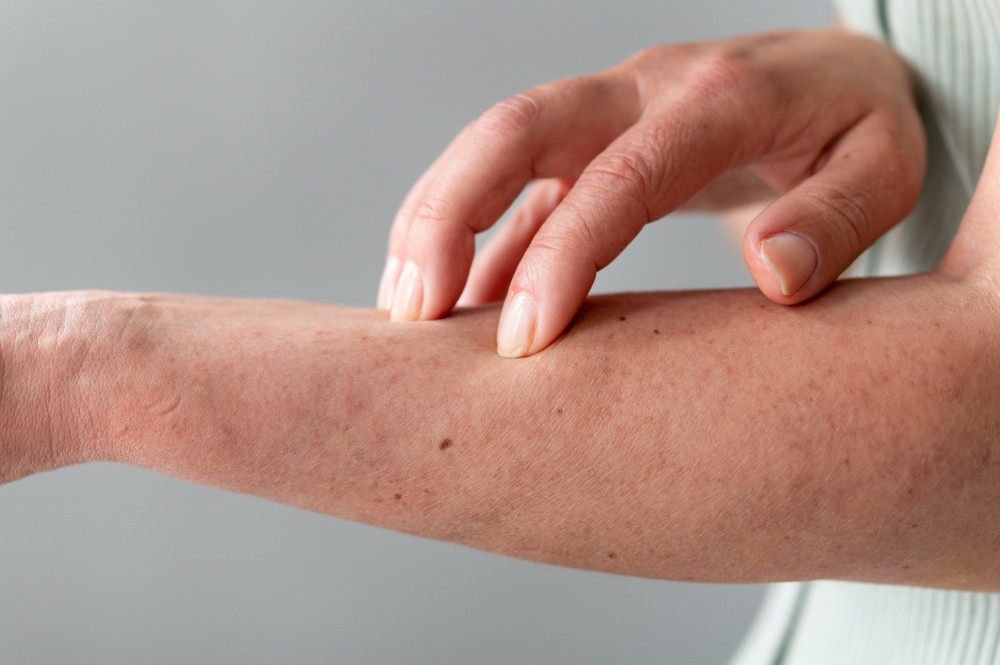Skin infections can develop when bacteria infect the skin or enter the tissue under the skin through wounds, scratches, punctures, or even bites. Skin infections may range from mild to severe.
Mild skin infections are treatable at home with the right treatment. Meanwhile, more severe skin infections necessitate additional medical treatment. Infections can start in a specific area of the skin or spread throughout it.
Characteristics of Skin Infections
Skin infections are characterized by several symptoms, including:
- Pus or fluid discharge from the wound
- Redness of the skin area around the wound
- The infected area of skin feels warm
- Pain when pressed
- The growth of a yellowish crust or like a pimple
- Wounds that look like blisters
- The pain in the wound gets worse after a few days
- Swelling of the wound is getting worse
- Fever
- After ten days, the wound has not spontaneously healed
Read more: 5 Habits That Turn Out To Be Unhealthy For The Skin
Causes of Skin Infections
Skin infections can be caused by various types of germs, including:
Bacteria
In fact, a lot of bacteria that are on the skin or come into contact with it would not typically cause an infection. Therefore, hair follicles, minor cuts, scratches, punctures, burns, animal or insect bites, or pre-existing skin conditions are the usual entry points for bacteria that cause infections.
Several activities can result in bacterial infections. After swimming or gardening in a contaminated area, you could contract the infection. Staphylococcus and Streptococcus bacteria are typically the ones that cause the majority of skin infections. Additionally, bacterial infections can only affect a single patch of skin, or they can spread widely and result in body-wide symptoms such as fever.
A few examples of skin infections caused by bacteria are:
- Carbuncle
- Ecthyma
- Erythrasma
- Folliculitis
- Furuncle
- Impetigo
- Lymphadenitis
- Cellulitis
- Erysipelas
- Lymphangitis
- Leprosy
- Skin TB or scrofuloderma
- Syphilis
Virus
Viruses can also cause skin infections in addition to bacteria. The following are a few viral infections that are harmful to the skin:
- Herpes simplex
- Shingles
- Chicken pox
- Molluscum contagiosum
- Warts
- Measles
- Singapore flu (hand, foot and mouth disease)
Viral skin infections are frequently transmitted through direct contact with infected skin from other patients or through virus-containing droplets.
Fungi
The soil, plants, surfaces of our homes, and our skin all contain millions of different types of fungi. Fungi can occasionally result in problems with skin. Symptoms of fungal skin infections include blistering, redness, itching, swelling, and scaly skin.
Skin folds, such as the armpits, between the thighs, legs, or places where heat and moisture are persistent are common sites for fungal infections. There are several forms of fungal skin infections, such as:
- Tinea
- Ringworm
- Nail fungus
- Skin candidiasis
- Diaper rash
Parasite
Additionally, parasites that infiltrate the skin can cause skin infections. Some of the skin infections that parasites can cause include:
- Lice
- Bed bugs (bedbugs)
- Scabies or scabies
- Cutaneous larva migrans
Medication is necessary for parasitic skin infections in order to eradicate the parasite and relieve the associated symptoms. In order to prevent parasites from spreading and to prolong their presence in the body, treatment is essential.
Skin infections are more common in the elderly, diabetics, people with compromised immune systems, those who are malnourished, and those who are obese. To receive the proper treatment, you should see a doctor if you have skin problems like redness, swelling, pain, itching, or pus emerging out of the wound.
Looking for more information about other diseases? Click here!
- dr Hanifa Rahma
Angela Nelson (2023). Skin Infection. Available from: https://www.webmd.com/skin-problems-and-treatments/skin-infection-signs
Medline Plus (2023). Skin Infections. Available from: https://medlineplus.gov/skininfections.html
CDC (2020). Skin Infections. Available from: https://www.cdc.gov/antibiotic-use/skin-infections.html
Wingfield E. Rehmus, MD, MPH (2023). Overview of Bacterial Skin Infections. Available from: https://www.msdmanuals.com/home/skin-disorders/bacterial-skin-infections/overview-of-bacterial-skin-infections
MaryAnn De Pietro, CRT (2023). What To Know About Skin Infection Types, Causes, and Treatment. Available from: https://www.healthline.com/health/skin-infection
WebMD (2022). Fungal Infections of the Skin. Available from: https://www.webmd.com/skin-problems-and-treatments/fungal-infections-skin











